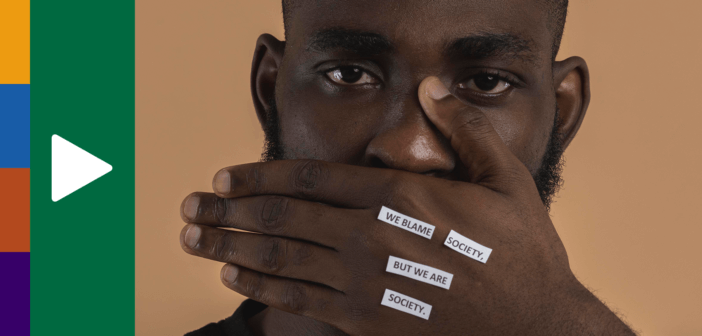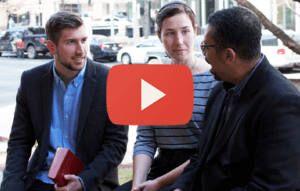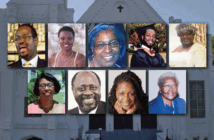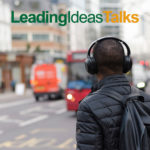
How can church leaders strive to be anti-racist? We speak with Sheila Beckford about strategies for equipping church leaders to do the hard work of anti-racism in order to work toward real change.
Listen on Apple Podcasts | YouTube Music | Spotify
Watch on YouTube
- Transcript — Click or Tap to Read
-
Announcer: Leading Ideas Talks is brought to you by the Lewis Center for Church Leadership of Wesley Theological Seminary in Washington, DC. Subscribe free to our weekly e-newsletter, Leading Ideas, at churchleadership.com/leadingideas.
Leading Ideas Talks is also brought to you by the free video-based study Moving Faith Communities to Fruitful Conversations about Race. This dialogue about race in America may be used to help your church bring people together to talk about moving forward bravely and boldly in the name of Christ. The study is divided into four 15-minute videos which may be used in one or more sessions. Watch now at churchleadership.com/videos.
How can church leaders strive to be anti-racist? In this episode we speak with Sheila Beckford about strategies for equipping church leaders to do the hard work of anti-racism in order to work toward real change.
Jessica Anschutz: Welcome to Leading Ideas Talks, a podcast featuring thought leaders and innovative practitioners. I am Jessica Anschutz, one of the editors of the Leading Ideas e-newsletter, and I am your host for this Leading Ideas Talk. Joining me is Sheila Beckford, Senior Pastor of John Wesley United Methodist Church in Brooklyn and co-author of Anti-Racism 4REALS: Real Talk with Real Strategies in Real Time for Real Change. Welcome, Sheila. Thank you for taking the time to talk with me today.
Sheila M. Beckford: Thank you for having me.
Jessica Anschutz: It’s a joy to see you, and I look forward to our conversation. Anti-Racism 4REALS offers real action steps for dislodging, disrupting, and dismantling racism. I really appreciated how the book helped me to think not only about my own experiences but also my role as a leader in the church and how we need real change in individuals and also on a systemic level. I want to invite you to start off by telling our listeners a little bit about your inspiration for the book and its distinguishing characteristics, as it’s different than many anti-racism texts.
Sheila M. Beckford: Sure, sure. The book was actually inspired by the work that both my coauthor, Michelle Ledder, and I do. We do anti-racism work. We think it, we eat it, we drink it. We are anti-racist trainers, as well as those who lead in this work by living it. And so we were actually leading an Anti-racism 101 course with GCORR (General Commission on Race and Religion), and I was assisting her in this. We came together to lead this training for the New York Annual Conference. Afterwards, we said, “You know what? We should write a book.” You know, I said that in passing. I think that was in August and by November, we had a contract.
So, we were basically inspired. How we met was through a mediation. She was supposed to mediate this meeting between me and another person who was racially terrorized at a Christian conference. And she was mediating, and I had to share my story as to what took place. And so I noticed how she and I had the same pedagogy. We were coming from two different racial identities, but it was the same way of handling anti-racist work. And so we just became instant friends from there. And that work took on a life of its own through our conversations and then we decided to write this book together.
What makes us different is we understand the history of racism. And we know it’s not going to be changed just by reiterating history. If that were the case, it would have gone away a long time ago. We understand that, in order to dislodge, disrupt, and dismantle racism, we had to give people entry points. Oftentimes, people believe they have to take so many trainings in order to begin anti-racism work, and that’s not the case at all. We can start immediately. And so we thought about how is it that we can produce something that shares with people strategies and ways to begin to do the work immediately and not feel so obligated to attend 50 trainings before you can say, “Okay, you’re ready to go,” when being anti-racist is just calling things out from the beginning and saying, “Okay. I recognize that and that’s racist.” If that’s the only thing that you can do, then that’s where you start. So, that’s what makes this very unique and different from the other anti-racism books and work that’s out there at this time.
Jessica Anschutz: Absolutely, and I appreciate that you talked about how there are so many different entry points into this work and that there’s a pathway for all of us, no matter who we are, whether we’re clergy or laity or we are working in another field. And one of those ways is what you just named in Real Talk — naming racism as it happens in the place where it happens to the people that experienced it or witnessed it. Can you talk a little bit and maybe give our listeners an example of how this might play out, what this might look like?
Sheila M. Beckford: Sure, sure, sure. So, we know there’s this thing called “parking lot conversations.” Something happens in the meeting, and then after the meeting everyone goes to the parking lot to discuss what happened in the meeting. And we think that perpetuates racism. And why is that? While you were in a meeting something went off in your head and said, “That was wrong. That is racist. That should not have happened.” Right? So instead of addressing it at that moment, instead of addressing it in real time, we wait until afterwards, after someone has spoken up and is usually the target. The target usually stands up to say “No, you will not talk to me that way. No. This is racist.” And you and everyone else in the room is silent. Then, when you leave that space, many of us receive emails like, “I like how you handled it.” “Yes, that was wrong what so-and-so said and what they would do,” and “I can’t believe they said that.” And in that moment is when you’re just causing more harm because when you could have stood up, when you should have stood up. When you had the opportunity to disrupt it in real time, you did not take the opportunity. Instead, you are shielding yourself and allowing the person who was targeted to receive all the brunt, all the harm, the brunt of the harm. And you’re sitting back just because you want to remain in your status. You want your status to remain, your social status to remain, or wherever you are in your workplace. You do not want to look as if, “Okay, if I defend this person, then I’m going to become the target, so I’m going to tell them afterwards ‘I agree with you’ and it doesn’t matter afterwards.” A parking lot conversation is just that. A parking lot conversation does nothing to help or decrease the harm or interrupt the harm the target is receiving at that point.
Jessica Anschutz: And I would say that applies to all parking lot conversations, whether they are related to issues of race or other things in the church, right? They often cause more harm than they are productive because we’re not bringing the conversation to the table where they need to be discussed and where the players are.
Sheila M. Beckford: Right, but we particularly put an emphasis on race because race is where we are remaining silent. These other parking lot conversations do not. They may cause harm, but when it comes to racism and silence when stuff happens, you are talking about another human being as a person. You know another human being is being affected and it doesn’t stop there. It doesn’t stop there. Most of the time the people who have no idea that harm is being done are white people.
Jessica Anschutz: Absolutely.
Sheila M. Beckford: You know, they don’t pick up on it. And so that’s why it’s so important, if a white person does hear it, to jump in like, “Nope, that’s racist. That is absolutely racist.”
Jessica Anschutz: Absolutely, the importance of naming it in the moment and not letting it wait until later in the parking lot or the hallway or letting it build up until it comes up in a bigger issue or venue or situation but naming it in the moment. And how toxic it is and harmful and hurtful it is when we don’t speak up, especially when we — I speak as a white woman — do not speak up. As you think about your work as a pastor and an anti-racist educator, how do those aspects of your lives intersect? How does anti-racism shape your ministry, your preaching, your teaching, your work on the ground?
Sheila M. Beckford: Well, anti-racism, anti-racist work affects my whole life. There’s not a place that I can enter where I am not hearing a microaggression or just down straight, blunt racist behavior and comments. And so, it’s like I’m always on. My ears are always listening and always perked, even in my own community where we often perpetuate harm because of white supremacy and how we have internalized it, you know, through colorism and different ways of making people feel “less than” because we were born black, you know. And that’s just the race, right? So, we’re really brown. But that’s the race in this country. It’s black. So, it is impossible for me to turn it off. It affects me at all times. I’m always looking at my situation through that lens and I’m paying attention to the injustices that happen in our communities. And I’m always trying to decipher, “Is this because of race or is it because of something else?” Am I seeing racism everywhere I turn? No, I don’t. I don’t say “that’s because of racism” when it’s not, but when it is, my ears are very attuned to it.
As far as preaching and teaching, it’s in my sermons. It comes out of me because that’s how I see the scripture. I can find injustice and justice in every scripture, so it’s hard for me not to include it in a sermon because I think that’s who God has created me to be and that’s the lens that God wants me to look through. So, I have to use that gift to actually speak out and bring awareness to others, especially in my community. When I’m in other communities as well, I’m bold and audacious. I’m going to speak the truth. I’m not going to shy away from it. I’m not going to be silent. I’m going to speak the truth. I’m going to say, “Well, I’m sorry but I’m really not sorry. But this is the circumstance, and what you’re saying right now is actually causing someone, a group, harm.” So, it’s in my teaching, the way I teach my young people, you know, and I listen to them, as well, so they’re sharing this information with me as to what they see or what they hear. And I’m not going to tell them that’s not true because it absolutely is true. But I am going to teach them strategies or how to manage and navigate this system that causes, that perpetuates, racism and causes harm to many groups.
Jessica Anschutz: Absolutely, and those strategies are so important. I really liked in the book how you outline the strategies and how you identify the unique strategies for white people, right? If you’re a white person, this is the pathway that you should follow for a strategy based on a particular situation. And you also lift up why it’s important to be prepared for these situations. Can you talk a little bit about that? About the preparation work that we all need to do in order to be able to respond with real talk.
Sheila M. Beckford: Right. So many times, as I said before, white people don’t pick up and say, “Okay, that’s racist.” They’ll say like “Oh, that just doesn’t sound right.” But they can’t identify why it doesn’t sound right. And so Reverend Michelle and I are saying you have to be prepared. You have to start really focusing on people’s language. If it makes sense to only white people, that’s a problem because that’s that logic that continues in your language that only white people understand, only white people understand why they benefit or how they benefit and do not understand why the other group is not benefiting or don’t want to understand why the other group is not benefiting.
If we’re doing anti-racist work, anti-racism work, we have to actually practice. Just like anything else, you have to practice because your ears are like babies, right? When babies start to learn different sounds, they start to imitate those sounds. When they start to walk — many parents and their children walk just like each other. If you look at them walk ahead, they have the same mannerisms and that’s basically because they’re watching and practicing, and I think it has to come to a point where it’s just organic. “I hear it. I see it. I speak it. I disrupt it.” We’ve got to, in real time, bring about some change, and not change that is not sustainable, but change that is sustainable. Policy changes. Not just putting BIPAL (Black, Indigenous, Pacific Islanders, Asian, Latino/X) people as the face of our business, but actually valuing the strategies of BIPAL people to change the policies that keep people oppressed, BIPAL people oppressed.
Jessica Anschutz: Absolutely. And the importance of change on all levels, starting with individuals and moving out, is so important. You mentioned the anti-racism work happening in real time. Talk to our listeners about what you mean when you say real time.
Sheila M. Beckford: You know, we’ve been talking about it. You know, every time we said something, we say, “In the moment. In the moment. In the moment.” And for us, that’s real time. Real time is not waiting to pull someone into a private session to say, “You know, what you said was racist.” Like I said, the majority of people who do not know it’s racist are white people, so for the benefit of white people, you say it in public. And for the benefit of valuing or restoring dignity to that person who’s being targeted and to the entire situation is to do this thing in real time. So, we give an example in the book, the Matthew text, and we talk about if my brethren offends …, you know, go talk to the person, and then if he or she doesn’t …, then you bring two more people, and then you take it to the whole community. And that’s the scripture that’s normally used when we talk about interrupting in real time.
We’ve had workshops where one person, a couple of people, … I remember this one woman in particular said, “Do you think I’m going to embarrass someone and say that what you said is racist?” And our response is, “So, it’s okay for that person to be devalued and embarrassed by the comment and the racism, but it’s not okay for the person who said it to be checked and to be told in public that this is wrong?” We continue to use that scripture to allow racism to hide in plain sight. We continue to use that scripture to allow us to shy away from doing anti-racism work. And so, in order to be anti-racist and in order to practice anti-racism, we must deal with the issue when it arises in real time. We must disrupt it, dislodge it, and dismantle it in real time in the moment.
Jessica Anschutz: Absolutely. In your response, Sheila, you touched on excuses and the excuses that white people make for not engaging it in real time with real talk. Also, in your book you talk about the excuses that particularly white people make for not even engaging anti-racism work. Talk a little bit about how some of the real strategies in your book and in your work empower leaders with alternatives to these excuses.
Sheila M. Beckford: Right. Reverend Michelle Ledder actually wrote that chapter for white people. The excuse that we hear basically is “I’m not ready. I don’t know what to say.” When we talk about these excuses, we also say that you have to go beyond those excuses. And so, these excuses are why we wrote this book. It removes your excuses. We have given you 137+ strategies to prepare you to do the work if you truly want to do the work. So, we have no excuse now. Right? Now, if you say, “I don’t know where to begin. I read this book, but I don’t know where to begin,” we can most definitely say you do not want to do anti-racism work because it is in the palm of your hand. We have given you exercises. That’s why it looks like a workbook because writing helps us to remember, and it also allows you to go back and read what you wrote so that you can be prepared. In the beginning, you’ll see that many people will not have great answers in the beginning of this book. We start with the action now learning engaged. We know in our heart that it will be so difficult for a person to respond who just never did this work before, so it will be so difficult for them to give us the anti-racist responses that we were looking for. But, by the end of the book, you should be able, you should be ready and prepared to go back and say, “Okay. Now I see how I would have perpetrated harm by doing it this way.” So now we’re at the end of the book and now you have all the strategies. You can go back to your first statement, back to the first exercise, and now respond, now that you have more tools in your toolbox to combat racism.
Jessica Anschutz: Absolutely. I really appreciate the workbook aspect throughout the book and also the information in the appendices that helps you fill in those blanks if you weren’t prepared to fill them in yourself as you journey through. It’s a wonderful resource. In thinking about our work to become and to be and to empower anti-racism in life and ministry, what are the things that we as practitioners need to do to nurture ourselves to enable us to continue to do this work?
Sheila M. Beckford: In the book, I mentioned rest. And I particularly mentioned it for BIPAL people. Because as I said to you, every day we’re on. Every day we encounter racism. And it doesn’t work the same for white people. White people can walk away from anti-racism work. “I’m done. I did my part. I think I did my part. I’m done. We going to give it back to the BIPAL people. They know what they’re doing.” But that’s not it. Right?
So, the way that we nurture one another is that we BIPAL people provide strategies for white people to follow. And along the way, we work together as far as checking back to see if this is the correct way to do this strategy. Because we come from two different racial positionalities. And so, you may read something and interpret it one way, and it was written by BIPAL people from their lens, their racial positionality, their experiences, our understanding of what humanity looks like. And then it sometimes can be co-opted because there’s not an understanding. White people can’t basically understand what BIPAL people have gone through. Oftentimes, when white people receive the strategy, they decide when it’s time to do this work, not when BIPAL people say, “Okay it’s time now.” “No, no, no. It’s not time yet. They’re not ready yet.” And BIPAL people are to wait until white people are ready to move into the work.
I believe that even if we’re working together and the BIPAL people create the strategies and white people do the work, that’s nurturing right there. It’s allowing BIPAL people to get that rest to move away from this constant doing, doing, doing and trying to eradicate racism. It’s exhausting work. It’s traumatizing work, especially for BIPAL people. And so BIPAL people need to step back and rest. And people need to nurture that relationship and allow them to do so. And then not so much allow them, but “Okay, we’re going to continue to work, while you rest.” I think that’s nurturing on both sides.
Learn to Talk Honestly and Openly about Faith and Race Race with this Free Video-based Study
Moving Faith Communities to Fruitful Conversations about Race is a dialogue about race in America and may be used to help your church bring people together to talk about moving forward bravely and boldly in the name of Christ. The study is divided into four 15-minute videos which may be used in one or more sessions. Watch now at churchleadership.com/videos.
Jessica Anschutz: In the book you lift up several examples of cases where white people in positions of leadership took on the ideas of BIPAL people and claim those ideas as their own, rather than citing the original source and lifting up those BIPAL voices. Talk a little bit about the need for us to be aware of those situations and to speak up and to how we can work together to prevent those situations from happening in the future.
Rev. Sheila M. Beckford: Oh, absolutely. So, I believe we talked about that in a CEO setting, where a CEO sat down and heard the ideas of BIPAL people and basically called it problematic. And then it appeared again with the CEO’s name on it. And many of our scenarios, if not all of them, are based on real life. What was important about that in real life was that a few allies, white allies, stepped up. Every time the CEO mentioned these new ideas, there were white people who would say “That came from that BIPAL group” and constantly make it known that it was ideas stolen from a group that you now claim to protect, so the protection is not really there. You know, all of that is a farce because the damage is done. The work, the ideas, all of the blood, sweat, and tears from that particular group was problematic when it came from that particular group. It was knocked down as problematic. And then it resurfaced with the CEO’s name on it. And so, at every opportunity that those allies — I’ll say accomplices — made sure that they were in every setting and said, “Oh, no. That came from that BIPAL group.” And they would ask the question, “When are you going to give credit to that BIPAL group? These are the same words. This was submitted to you this day by that powerful BIPAL group. We have a copy that came from them. When are you going to give them credit for the work that they have done?” And I think that was, that is, a very powerful example of how we need to protect ideas of BIPAL groups, and the protection needs to come from our white allies and accomplices.
Jessica Anschutz: As we wind down our time together, Sheila, I want to invite you to talk about your hope for the Church, as it seeks to be anti-racist.
Sheila M. Beckford: Okay. So in the last chapter of our book, we talk about sustainable change — not change that looks good on paper, but actual change in policies. Because you can have change and say “Okay, we’re going to have this change on paper.” But if you still have the person in power who is making it difficult for this change to happen, those policies are not going to change. There will always be loopholes where oppression is going to seep through, where racism is going to actually happen within that corporation or organization. So as far as the Church is concerned and, I have to say, as far as the United Methodist Church is concerned, I still see those leaders at the top being rewarded and promoted for the things that they do, and a lot of the things that they do perpetrate harm. A lot of the things that they have done continue to promote oppression and racism.
Standing in the middle of a fence, straddling both sides, is not leadership. It’s not leadership. Burying work of BIPAL people because it’s too difficult for a person in leadership to handle will never bring about change. It will never bring about anti-racism.
Jessica Anschutz: I very much appreciate you sharing what you have shared with me and the work that you were doing beyond our time together here. As you think about clergy and laity doing the work to be anti-racist, what words of encouragement do you have for them for the work ahead?
Sheila M. Beckford: I want to be honest and say this is not easy. As white people, you’re going to come to a realization that much of what you have been taught, your upbringing, some of the actions that you have displayed already in your life, were racist. And I’m going to say, yes, it happened, but now it’s time to do something. You have entry points. You have strategies. You know, I think that if you want to do this work, I know if you want to do this work, you will do this work. And you’ll get tired. You will be tired because this is some exhausting work. And sometimes you’re going to fall back, and you’re going to continue to perpetrate that harm because you are coming from a different racial positionality than I am. But don’t stop because you cause harm. Apologize. But don’t put any “buts” in the air. “I was trying to do ….” Just simply say, “I’m sorry.” And keep pressing to do better each and every time.
But those of us who are BIPAL people, we have a lot of work to do as well. We have internalized racism. We have caused each other harm. We have practiced colorism. We allow white dominant groups or spaces to dictate how we are to live, how we are to dress, what culture we are to practice by giving up our own culture and embracing whiteness. We have also caused each other harm by doing the bidding for white people or white supremacy and coddling white manipulation and allowing it to seep into our own communities, and always protecting it. So, I’m just going to say that we need to practice resilience and resistance. We have to resist that lure, whatever it is, about white supremacy that looks good to you. You need to step back and say, “Is it worth it?”
And I think the last thing I’ll say to give you some encouragement is that it can be done. It can be done as soon as you close the book or click “leave meeting.” The work is calling you. If your heart is pulled to this area of anti-racism work, go ahead and get with it. Get into it. You can start immediately. And please don’t let anyone distract you or deter you by saying you have to do cultural competency training or 10 courses of anti-racism work you’ll never get done. Immediately, you can do this work, and we’re rooting for you.
Jessica Anschutz: Thank you so much, Sheila, for taking the time to talk today and blessings on your work and in ministry. I know that our readers and our listeners will be inspired by what you have shared with us.
Sheila M. Beckford: And so, on behalf of Anti-Racism 4Reals, we thank you for this time and we thank you for allowing me, as a BIPAL person, for my voice to be heard, I thank you.
Announcer: Thank you for joining us for Leading Ideas Talks. Don’t forget to subscribe free to our weekly e-newsletter, Leading Ideas, to be notified when new episodes are published. Visit churchleadership.com/leadingideas.
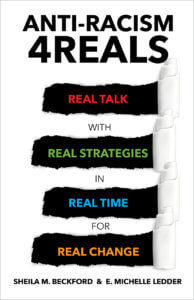 Related Resources
Related Resources
- Anti-Racism 4REALS: Real Talk with Real Strategies in Real Time for Real Change (Chalice Press, 2021) by Sheila M. Beckford and E. Michelle Ledder. Also available at Cokesbury and Amazon.
- Moving Faith Communities to Fruitful Conversations about Race, a free video-based adult Christian study from Wesley Theological Seminary
- Centering Marginalized Voices to Lead Change by Tyler Sit and Jessica L. Anschutz
- Challenge and Opportunity for Predominantly White Churches by Lovett H. Weems Jr.
- “Tackling Tough Topics in Church,” a Leading Ideas Talks podcast episode featuring Elizabeth Hagan

